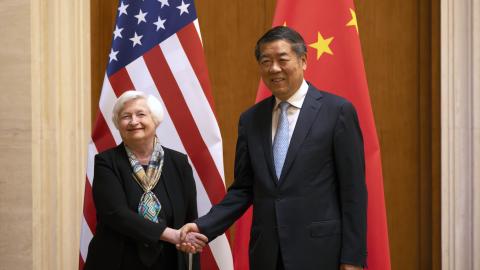Few observers expected breakthroughs during the recent U.S. Cabinet-level official visits to China—and there were none. Even a presidential summit would only provide a necessary but insufficient condition for a substantial improvement in the intensely strained Sino-American relationship.
Antony Blinken’s trip to Beijing last month marked the first visit by a U.S. Secretary of State to the PRC in five years. Treasury Secretary Janet Yellen’s early July sojourn in Beijing was the first high-level U.S. government direct engagement with China’s recently appointed team of senior economic policymakers. Special Presidential Envoy for Climate John Kerry is heading to China to restart high-level climate talks. Meanwhile, Foreign Minister Qin Gang accepted Blinken’s invitation to come to the United States. Yet, whether PRC President Xi Jinping will meet U.S. President Biden later this year remains unclear.
Washington’s general goals for these meetings include communicating areas of interest and concern, exploring potential avenues for cooperation, and establishing means for regular Sino-American communications. The specific priorities of the State and Defense Departments are to establish guardrails against inadvertent military clashes, avert crises involving Taiwan, discuss regional security challenges, prevent Chinese military assistance to Russia’s war against Ukraine, end narcotics trafficking, and curb arbitrary detentions of Americans. The immediate objectives of the U.S. economic policymakers are to level the playing field for U.S. companies in China’s market by ending unfair competitive practices, to keep Chinese firms from helping Russia’s war machine, and to pursue opportunities for Sino-American cooperation on climate finance, restructuring of sovereign debt, and other global challenges.
Both sides implausibly deny that they see their relationship in terms of great power conflict. U.S. officials did acknowledge, however, that they perceive “healthy” competition as the dominant framework for guiding the Sino-American relationship. They still believe that the two countries can avoid conflict through crisis management mechanisms while cooperating on select areas of mutual interest. Though denying they sought to separate the Chinese and U.S. economies, the U.S. side acknowledged they aim to reduce the risks of bilateral economic disruptions by diversifying select supply chains.
Chinese officials likewise say they seek mutual wins but think this goal requires Washington to “see the light” and change its incorrect policies. (Ironically, this had been the previous U.S. approach, striving to transform China into a “responsible stakeholder” that upheld U.S.-favored international rules.) Chinese analysts discern little difference between “de-risking” and “de-coupling.” They denounce U.S. economic measures such as tariffs, export controls, denial of investment opportunities to Chinese firms like Huawei and TikTok, and other trade and investment actions as concealed forms of containment to hobble China’s growth and sustain U.S. economic hegemony.
In terms of process, Blinken and Yellen held lengthy multi-hour talks with senior Chinese officials over several days. Though Blinken met with President Xi, the most productive encounters were likely Yellen’s sessions with China’s new economic leadership team. She also welcomed the opportunity to gain a first-hand assessment of the state of the Chinese economy and consult directly with U.S. business leaders regarding the Chinese investment climate.
These meetings saw frank exchanges of views and differences. For example, Yellen related the Chinese assessment that one reason for their lower-than-expected growth since the end of the COVID lockdowns earlier this year has been the high savings rate of Chinese consumers, which has dampened commercial activity. Meanwhile, Yellen confirmed that the Biden administration might impose additional controls on outbound investment to China and take other measures to protect U.S. military advantages. She insisted that these actions would be transparent, narrowly targeted, and would not have a broadly adverse impact on commercial activity.
Administration officials have described their approach as “small yard, high fence”. Yellen also expressed concern about recent Chinese decisions restricting transactions with U.S. firms like Micron and the export of gallium and germanium, used to manufacture semiconductors. The U.S. side considers these steps as possibly leading to a cycle of escalatory retaliations. She pointed out that China has also applied controls on outward investment. In practice, national security considerations trump economic priorities in both countries. Their governments regularly incur economic costs to achieve military advantages over the other.
In terms of substance though, neither the Blinken nor the Yellen trip saw a resolution of any disputed issues, namely because neither side changed its position on these questions. For example, Yellen stated at the end of her trip that U.S. concerns regarding PRC coercion against American companies in China will have to be addressed “over time” through further work. Reports that PRC and U.S. negotiators made progress curtailing use of Chinese-made precursor chemicals to manufacture fentanyl seem belied by the subsequent launch of the Global Coalition to Address Synthetic Drug Threats. Even if China-U.S. relations improve, Western companies contemplating reducing their exposure to the Chinese market will remain concerned about the PRC government’s crackdown on both foreign and domestic hi-tech firms, the new counterespionage law limiting foreign access to commercial data, and Western government and consumer actions disincentivizing commercial ties with China.
In both the military and economic planes, the Biden administration has prioritized expanding transparency to manage the China-U.S. competition. Blinken, like Secretary of Defense Lloyd Austin, has stressed the urgency of constructing “guardrails” to prevent an inadvertent war between China and the United States. Yellen stated that the administration would make clear the rationale for all commercial restrictions involving China. Yet, additional bilateral confidence-building and transparency measures are of limited value if existing ones remain unused. One can take a look at many recent examples; during the spy balloon episode earlier this year, the PLA refused to pick up the phone when Secretary Austin called them. Commercial transparency is also becoming harder to achieve given how semiconductors, artificial intelligence, and other advanced technologies underpin modern weaponry.
Yellen said her trip helped put China-U.S. relations on a “surer footing.” The recent Sino-American high-level meetings might stabilize the relationship in the short term, though unanticipated external shocks frequently disrupt ties. The exchanges have probably established the basis for more frequent lower-level staff meetings in the months ahead in bilateral working groups and other mechanisms. However, it will likely require a Biden-Xi presidential meeting, which may occur later this year, for authoritative substantive policy changes. Even then, the Chinese government may prudently await the results of the November 2024 U.S. elections before making major decisions.

















